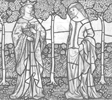Abraham Merritt
Abraham Merritt - usually credited as "A. Merritt" - was a leading fantasist in his day, but largely forgotten today. Moonlighting from his day job as a mainstream magazine editor, Merritt wrote a series of novels straddling the line between science fiction and fantasy, replete with macho fish-out-of-water heroes, lost races, beautiful women, and malignant superhuman presences: sort of a cross between Edgar Rice Burroughs and H. P. Lovecraft.
Nowadays his occasionally overwritten and florid descriptive style is a turnoff for many readers, but his best novels - Face In The Abyss and Dwellers In The Mirage - are remarkably economical and fast-paced, each one packing a trilogy's worth of epic battles and drama into a few hundred pages.
In addition to the volumes reviewed here, Merritt wrote a horror novel set in the modern world, Seven Footprints To Satan (1927), and a novel fragment completed by Hannes Bok, The Black Wheel (1947).
(DBW)
|
 The Moon Pool (1919) The Moon Pool (1919)
Everyone has to start somewhere, and Merritt started off by ripping off Edgar Rice Burroughs. This story takes place in a subterranean world not unlike ERB's Pellucidar, as a hardy band of adventurers pursue their lost comrades down a rift in the Earth's crust, and find themselves among races of frogmen, dwarves, and impossibly beautiful women.
He even borrows minor ERBisms like describing the local units of measure in excessive detail.
There's very little supernatural element (aside from the Dweller in the Moon Pool), and the heroes make their way with guts, wits, and an occasional blast of gunfire. The main hero, Larry O'Keefe, doesn't get to tell his own story, which is a shame because his speech - peppered with American slang and Irish brogue - is a lot more interesting than the squaresville narrator William Goodwin.
So it's just run of the mill action-adventure, really, but it's interesting if you like his later stuff because so many of his dominant themes are introduced: there are ancient races of lost people; the hero has to choose between an incredibly beautiful dangerous woman and an unbelievably beautiful demure woman; many battles are ultimately resolved by brilliant pulsating light beams. And Merritt, a frequently published botanist, indulges that passion here, with sumptuous descriptions of flora both above and below ground. (DBW)
|
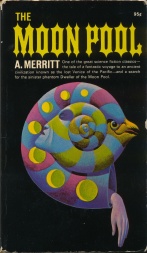
|
|
|
 The Metal Monster (1920) The Metal Monster (1920)
Writing in the aftermath of World War One, Merritt found a timely theme: mankind threatened by a soulless, merciless, hive-minded race of geometric metal shapes capable of combining into an endless variety of monstrous forms, like Lego blocks gone evil, able to destroy all life without a second thought. Unfortunately, he gets unbearably carried away in describing the animated cubes, pyramids and spheres - and their interminable journeys across the Tibetan landscape - to such an extent that writer and reader both forget that there's supposed to be a story in progress. There's a good fifty-page stretch where there's no dialogue aside from the occasional "Golly gee whiz!" interjection, and he never takes time to develop any interest in the human protagonists.
Merritt mixes in his usual elements, but they seem like afterthoughts: the exotic landscape is rarely described; the lost race of ancient Persians is barely discussed; the male-bonding banter between Goodwin (the same dullard from Moon Pool) and tough guy Dick Drake is forced. Even the inexpressibly beautiful, quasi-human, oft-unclad Norhala remains a cipher: not only do you not understand why she's been adopted by (yet seems to have some power over) the mechanical creatures, you don't care.
(DBW)
|
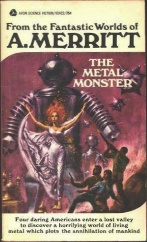
|
|
|
 The Ship Of Ishtar (1924) The Ship Of Ishtar (1924)
Merritt shifted focus sharply for this pure fantasy yarn
about a modern-day historian, John Kenton, who finds a miniature ship in a block of Babylonian stone and is soon drawn into a magical world of derring-do.
Much more bloodthirsty and crude than Merritt's other novels, and between the mightily-thewed hero, the skulking shaven-pated priests, and the beautiful, imperious (but quickly subjugated) love interest, it's easy to picture a young Robert E. Howard drinking deep at this fountain. Somewhat overwritten as well, with a huge number of one-sentence paragraphs ending in exclamation points, and he overuses the device of Kenton being drawn back into his own world at critical moments.
But Merritt does throw in a couple of his memorable minor characters - notably, the drunken King of the Two Deaths - he admirably resists the conventional ending, and as with his later stories, he strikes just the right tone with writing about superhuman characters (in this case, the gods Nabu, Nergal and Ishtar), not overawed by their magnificence, but not reducing them to just plain folks with special powers, either.
(DBW)
|
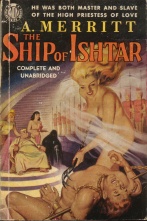
|
|
|
 Face In The Abyss (1931) Face In The Abyss (1931)
By now Merritt's ambitions were in conflict with his pulp sensibility, as he crammed an epic's worth of story into a few hundred pages.
The plot summary could make you think of Tolkien: a cataclysmic showdown between goodness and badness, with the last survivor of an elder race wielding long-forgotten weapons and leading the right-thinking men of Atlantis
against a Dark Master served by traitorous humans and a debased race of lizard-men, while the lovely Suarra must choose between immortality and the man she loves. With all this action - I haven't even mentioned the spider-men, dinosaurs, invisible Messengers or the Dream Makers - you wouldn't think there'd be much room for characterization or ambiguity, but the queenly serpent-woman Adana is wonderfully realized - a blend of superhuman wisdom, inhuman detachment, and very human vanity - and protagonist Nicholas Graydon spends most of the novel trying to figure out how he fits into this hallucinatory patchwork of creatures. Graydon gets into this whole mess by discovering a lost civilization (a frequent Merritt device) hidden in the Andes, and of course by falling in love with Suarra at first sight. The air of ancient mystery persists right up to the end, where Graydon (and the reader) isn't sure how much of the truth Adana is telling, and it's a fun ride. On the downside, some of the minor characters lack color (particularly the villain Lantlu), too many of the battles revolve around pulsing pillars of light, and the prose - while vivid enough, without the histrionics of Ishtar - is rarely striking.
(DBW)
|
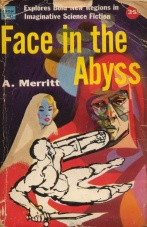
|
|
|
 Dwellers In The Mirage (1932) Dwellers In The Mirage (1932)
It can easily be argued that all fantasy is premised on the desire to return to bygone days when our needs were simple, when we believed in Santa Claus and Good overcoming Evil. By this point Merritt had developed a more sophisticated perspective, dealing with the tension between modern and primeval mores without taking the easy way out. Our latest scientist-adventurer hero, Leif Langdon, not only discovers a lost civilization or two, but also contains the spirit of a long-dead warrior-king locked away in his subconscious. As if that's not enough dualism, he meets and wins two beautiful women: the sweet, guileless Evalie, and the fearless, ruthless warrior-queen Lur.
Plus, he's either servant or master of the malevolent Khalk'ru, soul-drinking monster god from another dimension. How is Leif/Dwayanu going to sort all this stuff out? He doesn't, quite - just when you think there's a final resolution, the very last paragraph turns everything on its head - but he has a heck of a time trying.
Merritt had become quite an artful writer: he inserts the occasional purple passage, but generally keeps things moving at an appropriate pace (breakneck or thoughtful, depending on which half of Leif is in control). He still shares
Burroughs's proclivity for keeping his female characters nude whenever there's the slightest pretext, not that I'm complaining.
(DBW)
|
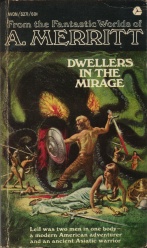
|
|
|
 The Fox Woman & Other Stories (1947) The Fox Woman & Other Stories (1947)
A posthumous collection of short stories (plus a couple of novel fragments), this doesn't show Merritt at his best but it's an interesting look at his unique position straddling the line between science fiction and fantasy. Apart from the title novella, which is a straight fantasy yarn, and the straightforward SF "The Last Poet And The Robots," all the main characters wonder if they're having true supernatural experiences or just experiencing the power of suggestion. One gets the feeling it's the former - particularly on the lushly written "The Women Of The Wood" - but the unsettling ambiguities are never resolved.
And the brevity of the pieces makes it easier to appreciate Merritt's talent at setting a scene, as his locations - whether a battlefield in France, a suite in Manhattan or a temple in the Yucatan - are rapidly and vividly realized. And while he doesn't have the space to introduce any lost races (apart from the offstage builders in "The People Of The Pit"), Merritt fans will be pleased to note that several stories feature mysterious, gorgeous, disconcertingly inhuman women.
(DBW)
|
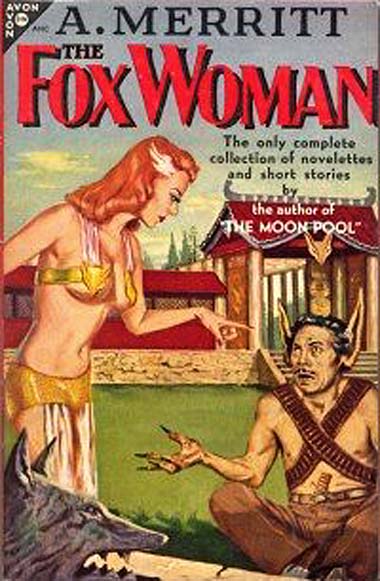 |
|
|
